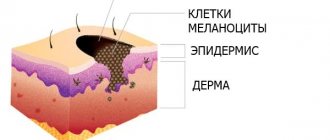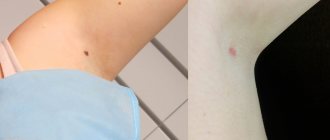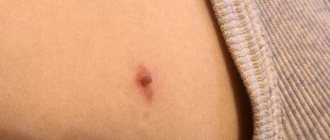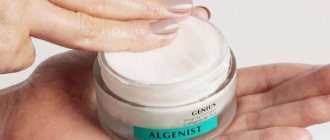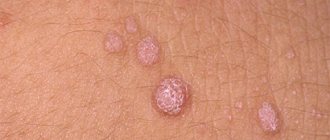Papillomas on the body often bring a lot of inconvenience to their owners. And if some are willing to put up with an aesthetic defect, then they are not willing to put up with physical inconveniences due to these growths. Removal of growths may be necessary as there is a risk that they will become cancerous. But there are situations when, after removal of the papilloma, the wound does not heal, such changes cannot be ignored, because such manifestations can cause scarring and other problems.
What happens to the wound after papilloma removal
When removing small papillomas, there are usually no special changes and the wound heals quite quickly. After removal, medium and large papillomas form a wound that can heal for a month and a half. In the first 24 hours it will be inflamed, and swelling around it often occurs.
After a couple of days, the damaged area changes, inflammation decreases, and a crust appears at the site of the papilloma. It plays a very important role, because due to this barrier, bacteria cannot enter the wound, and new epithelial tissue forms under the crust. In order for healing to occur faster and with minimal consequences in the form of a scar, you need to follow the recommendations of your doctor, and also treat the wound with special means.
For speedy healing, you need to follow your doctor's recommendations.
Video: “Removal of papillomas with liquid nitrogen”
Treatment after removal of papillomas must be carried out according to certain rules. The papilloma virus is quite common. Every 7 out of 10 people are infected with it. It can appear at any time, but most often this happens after a person’s immunity sharply decreases. Warts may not bother you at all. But there are risks of their spreading throughout the body, even damaging the mucous membranes.
How to care for a wound
Large wounds take a long time to heal, and some patients simply cannot stand it until this process is completed naturally. Less care is taken when treating the wound, which leads to additional damage. After removing a papilloma, you should not do the following:
- remove the crust that has formed (after each removal, healing begins all over again, and this also leads to an increase in connective tissue, that is, the appearance of a large scar);
- apply cosmetics, this includes foundations, moisturizers, various scrubs and other skin care products;
- expose to ultraviolet radiation;
- cover the damaged area with a plaster;
- provide additional moisture, hold the wound over steam, wet it with water, etc.
If you are cleaning the house, make sure that various chemicals do not get into the area where the papilloma is removed.
Treatment
One of the main questions patients have is how to treat the wound after papilloma removal? In fact, all products that have an antiseptic effect are suitable for this procedure. But not all of them can be used; some are too aggressive for the skin, which leads to unnecessary peeling. Treatment is a mandatory item when treating a wound after papilloma removal. Each case of removal of a growth should be considered individually, and a specific antiseptic is prescribed by the attending physician.
Before the top crust falls off on its own, the skin around it must be treated with special products. This is done in order to prevent infection from entering the damaged area of the skin. Typically, the following antiseptics are used for such procedures: brilliant green, iodine, ethyl alcohol. In some cases, it is permissible to treat the skin around the wound with a solution of potassium permanganate. But, you need to remember that a strong concentration of potassium permanganate solution can lead to burns. Use a weak solution of potassium permanganate for treatment.
In some cases, it is possible to treat the skin around the wound with a solution of potassium permanganate
Price
When visiting a clinic for tumor removal, patients most often focus on the cost of the procedure. In different clinics, the price varies depending on the city, the prestige of the institution, the complexity, the type of removal chosen, the size of the tumor and other factors. On average in Moscow, a laser papilloma removal procedure will cost 1,500 rubles.
Removal with liquid nitrogen will cost 1000 rubles per centimeter of tumor. Electrocoagulation will cost from 600 to 800 rubles. In other cities of Russia, a similar procedure will cost an order of magnitude lower, and the quality of tumor removal will not suffer as a result. A huge number of highly qualified specialists in the field of cosmetic surgery work throughout the country.
Special ointments
Over time, the crust will come off from the wound and a small pink spot will appear at the site of removal; some doctors recommend additionally treating it with special ointments. Such gels speed up the healing process and minimize the possibility of scar formation at the site of removal of the growth.
Methyluracil. Stimulates the process of regeneration in tissues, gives an anabolic and anti-catabolic effect. You need to use it 2 times a day every day.
Hydrocortisone ointment. This drug is used if the patient is constantly bothered by itching at the wound healing site. In addition, it will help relieve swelling and inflammation. The ointment practically does not penetrate into the bloodstream, so the likelihood of side effects is significantly reduced.
Solcoseryl. Allows you to accelerate tissue regeneration and becomes a simulator of cell proliferative activity. This drug helps prevent the formation of scars after papilloma removal. In the pharmacy you can see ointment and gel with this name on sale; in the case of treating removed papillomas, it is better to give preference to ointment. This product is also suitable for patients whose wound becomes wet after removing a papilloma, but in this case you need to use a gel. Your doctor will tell you how many times a day to treat the wound.
What should not be used to treat a wound?
To avoid problems with wound healing, you need to care for it in accordance with the doctor’s instructions, and not invent your own miracle methods. Quite often, women go to the hospital to remove growths on their faces. After removing the papilloma, under no circumstances should you smear it with creams, apply foundation or other cosmetics. The wound may fester, and the consequences will be unpredictable.
Other patients try to speed up the healing process using traditional methods, but this is not always beneficial. By using decoctions to moisten the affected area, the patient violates one of the rules of care, which is not to wet the wound. Antiseptic traditional medicines can also be highly concentrated, which will lead to new damage to healthy skin. Treatment with such means should be avoided even when the rough skin has come off and a pink spot has appeared. It will be possible to use those products that allow you to speed up regeneration.
Transmission routes
To accurately understand whether you can have sex with the HPV virus, you need to understand how it is transmitted.
It is quite easy to become infected with HPV at home, when using other people's personal hygiene items. Factors predisposing to the activation of the virus and the appearance of papillomas on the body and mucous membranes:
- immunodeficiency;
- stress;
- the presence of a chronic source of infection in the body;
- recent viral diseases;
- long-term treatment with antibiotics and corticosteroids.
If your immunity is greatly reduced, you can get the virus through a simple kiss or even by using someone else’s cup.
The papilloma virus can be transmitted even through a kiss
Complications
The process of removing unwanted growth itself does not pose a danger to human health. However, such consequences may arise that the patient will regret the choice made. Negative consequences arise if the patient does not properly treat the wound or does not protect it from negative effects.
Wound after papilloma removal
People who are not used to waiting will probably try to tear off the scab ahead of time; various infections can get into the open wound, which will lead to infection. Also, stripping off the roughness will lead to a longer recovery process. Lack of treatment with antiseptics and improper care lead to the fact that the wound takes much longer to heal, and it takes longer for the crust to separate.
There are situations when complications do not depend on the patient, for example, an allergic reaction to an antiseptic. There are cases when the patient fully complies with the instructions of the attending physician, but after removal of the papilloma, the wound does not heal, begins to get wet, and becomes inflamed. You urgently need to consult a doctor and find out the cause of this problem and begin to eliminate the negative consequences.
How to prevent complications
Some complications can be prevented by following simple recommendations:
- Before removing the papilloma, inform your doctor if you are allergic to any medications;
- do not expose the wound to ultraviolet radiation, water or chemicals;
- when the crust has partially come off, do not tear it off completely; if the protruding crust bothers you, carefully cut off the part that has already separated from the skin;
- if your doctor recommended that you use a certain antiseptic for treatment, use it, try not to replace it with analogues;
- If the wound does not heal for a long time, and new growths begin to appear under it, consult a doctor as soon as possible.
Pain during sexual intercourse
Patients often complain that it is painful to have sex after genital wart removal. Does this mean that you will have to forget about intimacy forever? During therapeutic therapy, sex is completely excluded. At the same time, any type of intimacy is prohibited - oral, anal and vaginal.
When the skin is completely restored, you can resume relationships with your sexual partner. Doctors should avoid unprotected contact for six months after surgery. Sometimes, in the case of therapeutic treatment, pain and burning may occur during intercourse. The main causes of pain are:
- small formations;
- repeated pathology;
- scarring of the mucous membrane.
If excision with a scalpel or radio wave therapy was used, the scars are quite painful and take a long time to heal. Until complete tissue healing occurs, intercourse will only bring discomfort, not pleasure. This is why doctors do not recommend rushing and do not give clear deadlines for returning to sexual activity, since each case is individual.
How to avoid scarring
Most patients are interested in the problem of the appearance of a scar after removal of papilloma. But it is better to prevent scarring; old scars are quite difficult to remove. Therefore, full compliance with the doctor’s instructions will help prevent the occurrence of scars; avoid amateur activities that lead to complications, including scars. After the crust is rejected, use special ointments; the doctor will tell you in more detail how many times a day to use them and how long to smear the damaged area.
Avoid removing growths in beauty salons. This approach can have serious consequences; lack of consultation with an oncologist and dermatovenerologist can lead to the development of skin cancer after removal of the growth.



